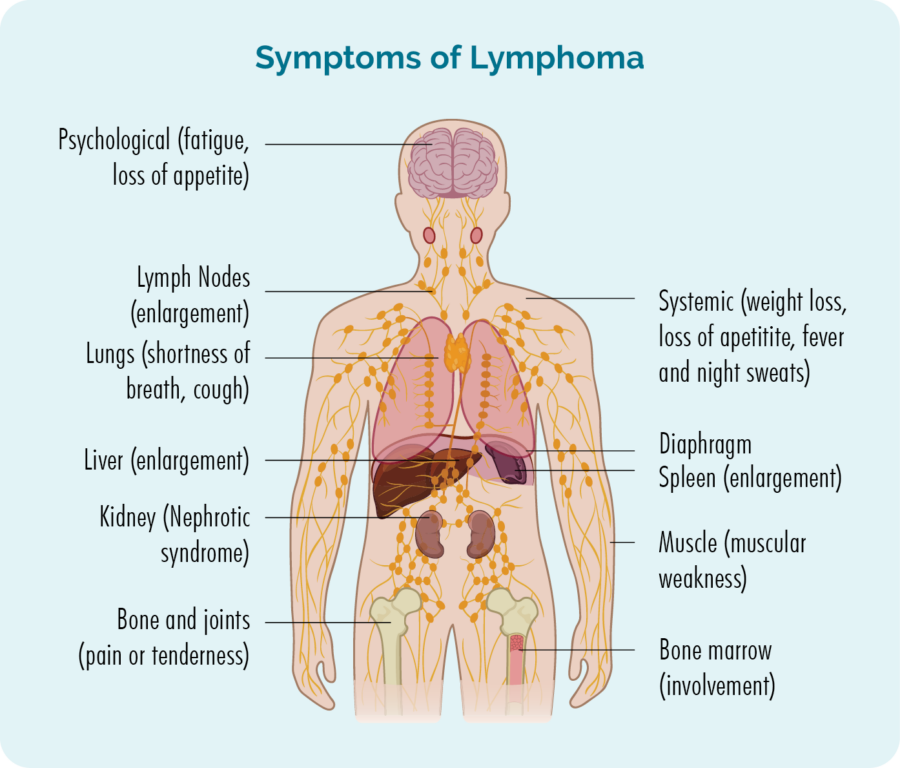Finding out you have lymphoma can be a very stressful time, but having the right information can help reduce your stress and help you plan ahead. This page will give you an overview of what lymphoma is, how cells normally grow, and why lymphoma develops, symptoms of lymphoma and its treatment as well as useful links.
Lymphoma is a type of cancer that affects your blood cells called lymphocytes. Lymphocytes are a type of white blood cell that support our immune system by fighting infection and disease. They mostly live in our lymphatic system with only very few found in our blood. Because they live mostly in our lymphatic system, lymphoma often does not show up on blood tests.
Our lymphatic system is responsible for cleaning our blood of toxins and waste products and includes our lymph nodes, spleen, thymus, tonsils, appendix and a fluid called lymph. Our lymphatic system is also where our B-cell lymphocytes make disease fighting antibodies.
Lymphomas have been called cancer of the blood, cancer of the lymphatic system and cancer of the immune system. But rather than being 3 types of cancer, these terms provide the what, the where and the how. Click on the flip boxes below to learn more.
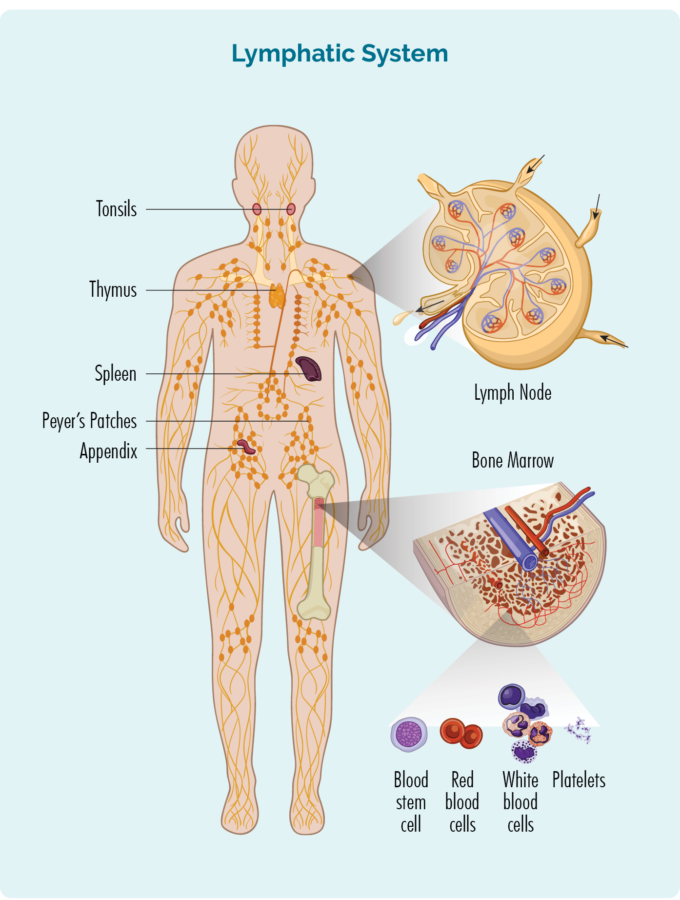
The What
The What
B-cells, which make antibodies to fight infection.
T-cells that can fight infection directly and recruit other immune cells.
NK cells - a specialised type of T-cell.
The Where
The Where
The How
The How
This affects your immune system's ability to keep you healthy and protect you from infections and disease.
If you haven’t already, you may like to visit our webpage on Understanding your lymphatic system and immune systems by clicking the link below. Understanding your lymphatic and immune systems will help you understand lymphoma a little easier.
We have two main types of lymphocytes:
- B-cell lymphocytes and
- T-cell lymphocytes.
This means you can have B-cell lymphoma or T-cell lymphoma. Some rare lymphomas are Natural Killer cell (NK) lymphomas – NK cells are a type of T-cell lymphocyte.
Lymphoma is further grouped into Hodgkin Lymphoma and Non-Hodgkin Lymphoma.
What is the difference between Hodgkin and Non-Hodgkin Lymphoma?
- Hodgkin Lymphoma – all Hodgkin Lymphomas are lymphomas of B-cell lymphocytes. Hodgkin Lymphoma is identified when the cancerous B-cells develop in a certain way and become Reed-Sternberg cells – which look very different from normal B-cells. Reed-Sternberg cells are not present in Non-Hodgkin Lymphomas. The Reed Sterberg cells also have with a specific protein called CD15 or CD30 on them. Click here to learn more about Hodgkin lymphoma.
- Non-Hodgkin Lymphoma (NHL) – these are lymphomas of all other B-cells or T-cell lymphocytes, including NK cells. Chronic Lymphocytic Leukemia (CLL) is also considered a subtype of NHL as it is essentially the same disease as Small Lymphocytic Lymphoma. There are more than 75 different subtypes of NHL. To learn more about the different subtypes, click the link below.
To understand lymphoma, you first need to know a bit about how the cells in your body grow.
How do cells normally grow?
Normally cells grow and multiply in a very tightly controlled and organised way. They are programmed to grow and behave in a certain way, and multiply or die at certain times.
Cells on their own are microscopic – meaning they are so small we can not see them. But, when they all join together they make up every part of our body including our skin, nails, bones, hair, lymph nodes, blood and body organs.
There are many checks and balances that happen to make sure cells develop the right way. These include “immune checkpoints”. Immune checkpoints are points during the cell growth where our immune system “checks” that the cell is a normal, healthy cell.
If the cell is checked and found to be healthy, it continues to grow. If it is diseased, or damaged in some way, it is either repaired or destroyed (dies), and removed from our body through our lymphatic system.
- When cells multiply, it is called “cell division”.
- When cells die it is called “apoptosis”.
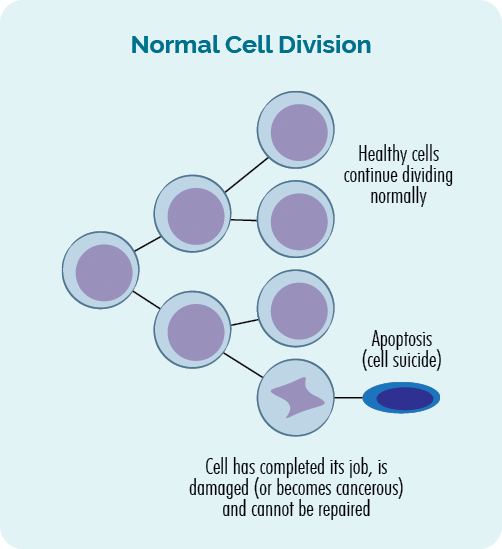
This process of cell division and apoptosis is regulated by the genes in our DNA, and is happening in our bodies all the time. We make trillions of cells every day to replace the old ones that have completed their job or become damaged.
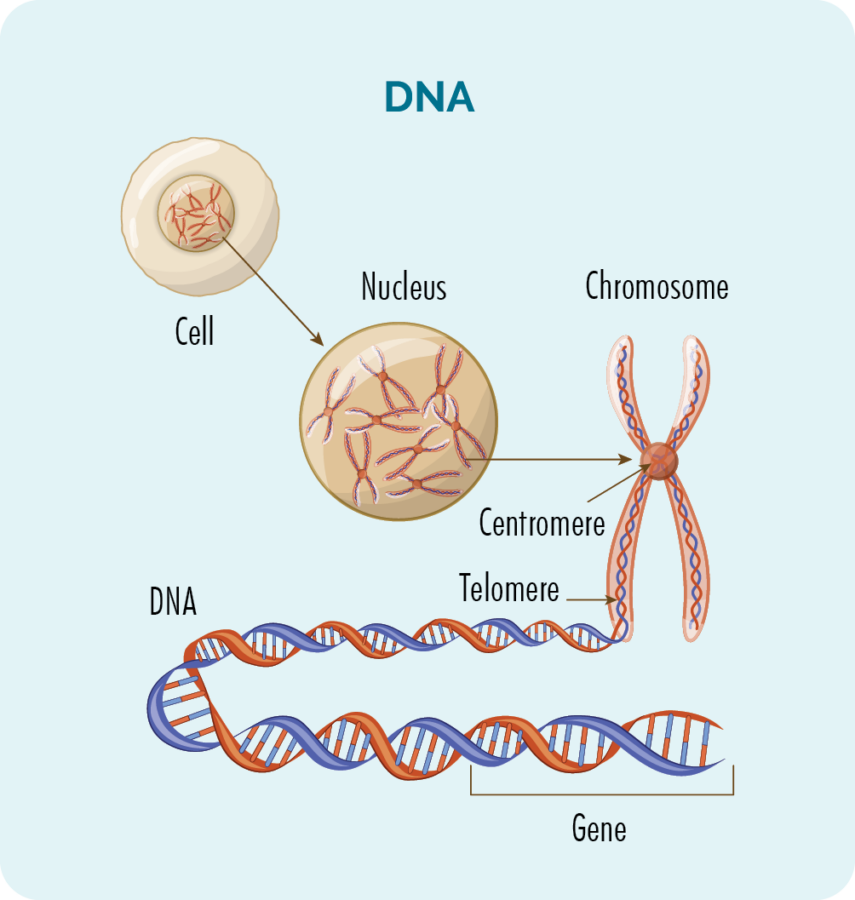
Genes and DNA
Inside every cell (except for red blood cells) is a nucleus with 23 pairs of chromosomes.
Chromosomes are made up of our DNA, and our DNA is made up of many different genes which provide the “recipe” for how our cells should grow, multiply, work and eventually die.
Cancer, including lymphoma and CLL occurs when damage or mistakes happen in our genes.
Learn more about what happens when our genes and DNA are damaged in the video below. Don’t worry too much about all the names of proteins and processes, the names are not as important as what they do.
What is cancer?
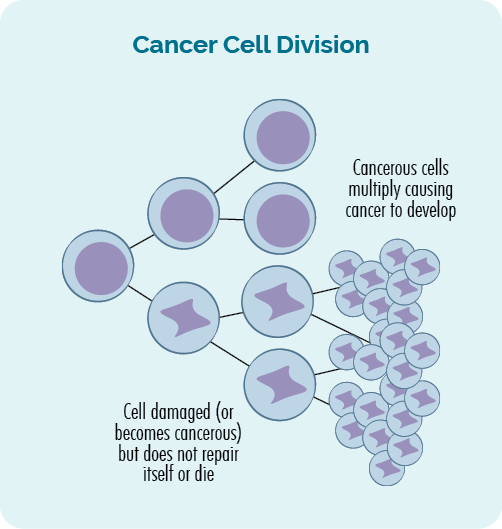
Cancer is a genetic disease. It occurs when damage or mistakes occur in our genes, resulting in abnormal, uncontrolled growth of cells.
In lymphoma and CLL, the uncontrolled and abnormal growth happens in your your T-cell or B-cell lymphocytes.
These changes to our DNA are sometimes called genetic mutations or genetic variations. They can occur because of lifestyle factors such as smoking, sun damage, heavy alcohol use (acquired mutations), or because of diseases that run in our families (inherited mutations). But for some cancers, we just don’t why they happen.
What causes Lymphoma & CLL
Lymphoma and CLL are one of the types of cancer where we just don’t know what causes them. There are some risk factors that have been identified, but many people with the same risk factors do not go on to develop lymphoma or CLL while others, with none of the known risk factors do.
Some risk factors may include:
- If you have ever had Epstein Barr virus (EBV). EBV causes mononucleosis (also known as “mono” or glandular fever).
- Human immunodeficiency virus (HIV).
- Certain diseases of your immune system, such as autoimmune lymphoproliferative syndrome.
- A weakened immune system after an organ or stem cell transplant. Or, from certain medications you might be taking.
- A parent, brother, or sister with a personal history of lymphoma.
More research is needed to identify the causes of lymphoma and CLL. Once a cause is identified, then we may be able to find ways to prevent it. But until then, knowing about symptoms of lymphoma, and seeing a doctor early is the best chance to fight it.
Overview of Lymphoma and CLL
Lymphoma affects more than 7300 Australians each year, and is the 6th most common cancer in adult men and women in Australia, but can affect people of all ages including children and babies.
It is the most common cancer in young people aged 15-29 years, and is the 3rd most common cancer in children aged 0-14 years. However the risk of developing lymphoma increases as we get older.
What do I need to know about my lymphoma?
There are over 80 different subtypes of lymphoma. Some subtypes are more common, and others are very rare. More than 75 of these subtypes are a subtype of Non-Hodgkin Lymphoma, while 5 are subtypes of Hodgkin Lymphoma.
It is important to know what subtype you have, because this can affect what type of treatment will likely work best for you, and how the lymphoma will progress with and without treatment. It will help you plan ahead, know what to expect and help you ask your doctor the right questions.
Lymphomas are further grouped into indolent or aggressive lymphomas.
Indolent Lymphoma
Indolent lymphomas are slow-growing lymphomas that often “sleep” and do not grow. This means they exist in your body, but are not doing any harm. Many indolent lymphomas do not need any treatment – particularly if they are sleeping. Even some advanced stage, indolent lymphomas such as stage 3 and stage 4 may not need treatment, if they are not causing symptoms and are not actively growing.
Most indolent lymphomas cannot be cured, so you will have the lymphoma for the rest of your life. But, many people can live a normal life and life span with an indolent lymphoma.
You may not have any noticeable symptoms when you have an indolent lymphoma, and can live with it for many years without any problems. For some people, it may not even be diagnosed until you to the doctor and get checked for something else.
One in five people with an indolent lymphoma will never need treatment for their lymphoma. However, indolent lymphomas can “wake up” and start growing. If this happens, you will probably need to start treatment. It is important that you let your doctor know if you start getting symptoms such as new or growing lumps (swollen lymph nodes) or B-symptoms including:
- Drenching night sweats
- Unexpected weight loss
- Temperature with or without chills and shaking.
In rare cases, an indolent lymphoma can “transform” into an aggressive subtype of lymphoma. If this happens you will be given the same treatment for the aggressive lymphoma.
Below is a list of the more common B-cell and T-cell indolent lymphomas. If you know your subtype, and it is listed here, you can click on it for more information.
Indolent (slow-growing) B-cell NHL
Indolent (slow-growing) T-cell NHL
Aggressive Lymphomas
Aggressive T-cell lymphomas can be a bit harder to treat, and you may achieve remission after treatment. However, it is common for T-cell lymphomas to relapse and need more, or ongoing treatment.
It is important to talk to your doctor about what the expectations of your treatment are, and how likely you are to be cured or go into remission.
Treatments for Lymphoma and CLL
Because of the many different types of lymphoma, there are also many different types of treatment. When making your treatment plan your doctor will consider all these things including:
- What subtype and stage of lymphoma you have.
- Any genetic mutations you may have.
- Your age, overall health and any other treatments you may be having for other illnesses.
- Whether you have had treatment for lymphoma in the past and if so, how you responded to that treatment.
Questions for your doctor
It can be overwhelming finding out you have lymphoma or CLL. And, when you don’t know what you don’t know, how can you know what questions to ask?
To help you get started we have put together some questions you can print out and take to your next appointment. Just click the link below to download our questions to ask your doctor.
Are there other types of blood cancer?
We have different types of white blood cells that play different roles in fighting infection and disease. Lymphoma is a cancer of white blood cells called lymphocytes. But because we have different types of white blood cells, other types of blood cancer exist, including leukaemia and myeloma.
Leukaemia
Leukaemia affects different types of white blood cells. The abnormal cells develop in the bone marrow or bloodstream. With leukaemia, blood cells are not produced the way they should be. There may be too many, too few, or blood cells that do not work as they should.
Leukaemia can be classified by the type of white cell affected, either a myeloid cell or a lymphatic cell, and how the disease progresses. Acute leukemia grows very quickly and needs treatment straight away, while chronic leukemia develops over a long time, and may not need treatment.
For further information please see the Leukaemia Foundation Website.
Myeloma
Myeloma is a cancer of a specialised, and the most mature form of B-cell lymphocyte – called a plasma cell. It is the plasma cell that produces antibodies (also called immunoglobulins). Because plasma cells have this specialised function, myeloma is classified differently to lymphomas.
In myeloma, the abnormal plasma cells make only one type of antibody known as paraprotein. This paraprotein has no useful function, and when too many abnormal plasma cells collect in your bone marrow, your body may find it hard to fight infection.
For further information please see the Myeloma Australia Website.
Summary
- Lymphoma is a type of blood cancer affecting white blood cells called lymphocytes.
- Lymphocytes live mostly in our lymphatic system and support our immune system by fighting infection and disease.
- Lymphoma begins when changes in our DNA results in unregulated and abnormal growth of cancerous lymphoma cells.
- Hodgkin Lymphoma and Non-Hodgkin Lymphoma are the main types of lymphoma, but they are further classified as B-cell or T-cell lymphomas, and indolent or aggressive lymphomas.
- There are many different types of treatment and the aim of the treatment will depend on the subtype of lymphoma your have.
- If you do not know the subtype of your lymphoma, or the significance of your subtype, ask your doctor.
